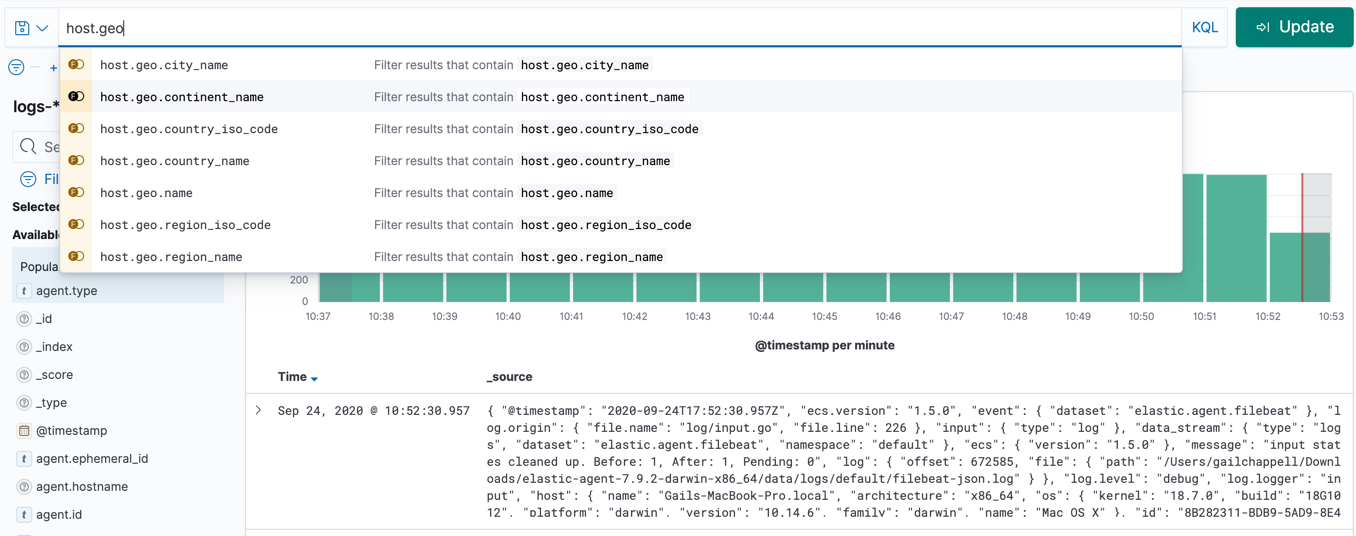Kibana Query Language
editKibana Query Language
editThe Kibana Query Language (KQL) makes it easy to find the fields and syntax for your Elasticsearch query. If you have the Basic tier or above, simply place your cursor in the Search field. As you type, you’ll get suggestions for fields, values, and operators.

If you prefer to use Kibana’s legacy query language, based on the Lucene query syntax, click KQL next to the Search field, and then turn off KQL.
Terms query
editA terms query matches documents that contain one or more exact terms in a field.
To match documents where the response field is 200:
response:200
To match documents with the phrase "quick brown fox" in the message field.
message:"quick brown fox"
Without the quotes, the query matches documents regardless of the order in which they appear. Documents with "quick brown fox" match, and so does "quick fox brown".
Terms without fields are matched against the default field in your index settings.
If a default field is not
set, terms are matched against all fields. For example, a query
for response:200 searches for the value 200
in the response field, but a query for just 200 searches for 200
across all fields in your index.
Boolean queries
editKQL supports or, and, and not. By default, and has a higher precedence than or.
To override the default precedence, group operators in parentheses.
To match documents where response is 200, extension is php, or both:
response:200 or extension:php
To match documents where response is 200 and extension is php:
response:200 and extension:php
To match documents where response is 200 or 404.
response:(200 or 404)
To match documents where response is 200 and extension is either php or css:
response:200 and (extension:php or extension:css)
To match documents where response is 200 and extension is
php or extension is css, and response is anything:
response:200 and extension:php or extension:css
To match documents where response is not 200:
not response:200
To match documents where response is 200 but extension is not php or css.
response:200 and not (extension:php or extension:css)
To match multi-value fields that contain a list of terms:
tags:(success and info and security)
Range queries
editKQL supports >, >=, <, and <= on numeric and date types.
account_number >= 100 and items_sold <= 200
Date range queries
editTypically, Kibana’s time filter is sufficient for setting a time range, but in some cases you might need to search on dates. Include the date range in quotes.
@timestamp < "2021-01-02T21:55:59"
@timestamp < "2021-01"
@timestamp < "2021"
Exist queries
editAn exist query matches documents that contain a value for a field, in this case, response:
response:*
Wildcard queries
editTo match documents where machine.os starts with win, such
as "windows 7" and "windows 10":
machine.os:win*
To match multiple fields:
machine.os*:windows 10
This syntax is handy when you have text and keyword
versions of a field. The query checks machine.os and machine.os.keyword
for the term
windows 10.
Nested field queries
editA main consideration for querying nested fields is how to match parts of the nested query to the individual nested documents. You can:
- Match parts of the query to a single nested document only. This is what most users want when querying on a nested field.
- Match parts of the query to different nested documents. This is how a regular object field works. This query is generally less useful than matching to a single document.
In the following document, items is a nested field. Each document in the nested
field contains a name, stock, and category.
{
"grocery_name": "Elastic Eats",
"items": [
{
"name": "banana",
"stock": "12",
"category": "fruit"
},
{
"name": "peach",
"stock": "10",
"category": "fruit"
},
{
"name": "carrot",
"stock": "9",
"category": "vegetable"
},
{
"name": "broccoli",
"stock": "5",
"category": "vegetable"
}
]
}
Match a single document
editTo match stores that have more than 10 bananas in stock:
items:{ name:banana and stock > 10 }
items is the nested path. Everything inside the curly braces (the nested group)
must match a single nested document.
The following query does not return any matches because no single nested document has bananas with a stock of 9.
items:{ name:banana and stock:9 }
Match different documents
editThe following subqueries are in separate nested groups and can match different nested documents:
items:{ name:banana } and items:{ stock:9 }
name:banana matches the first document in the array and stock:9
matches the third document in the array.
Match single and different documents
editTo find a store with more than 10 bananas that also stocks vegetables:
items:{ name:banana and stock > 10 } and items:{ category:vegetable }
The first nested group (name:banana and stock > 10) must match a single document, but the category:vegetables
subquery can match a different nested document because it is in a separate group.
Nested fields inside other nested fields
editKQL supports nested fields inside other nested fields—you have to
specify the full path. In this document,
level1 and level2 are nested fields:
{
"level1": [
{
"level2": [
{
"prop1": "foo",
"prop2": "bar"
},
{
"prop1": "baz",
"prop2": "qux"
}
]
}
]
}
To match on a single nested document:
level1.level2:{ prop1:foo and prop2:bar }